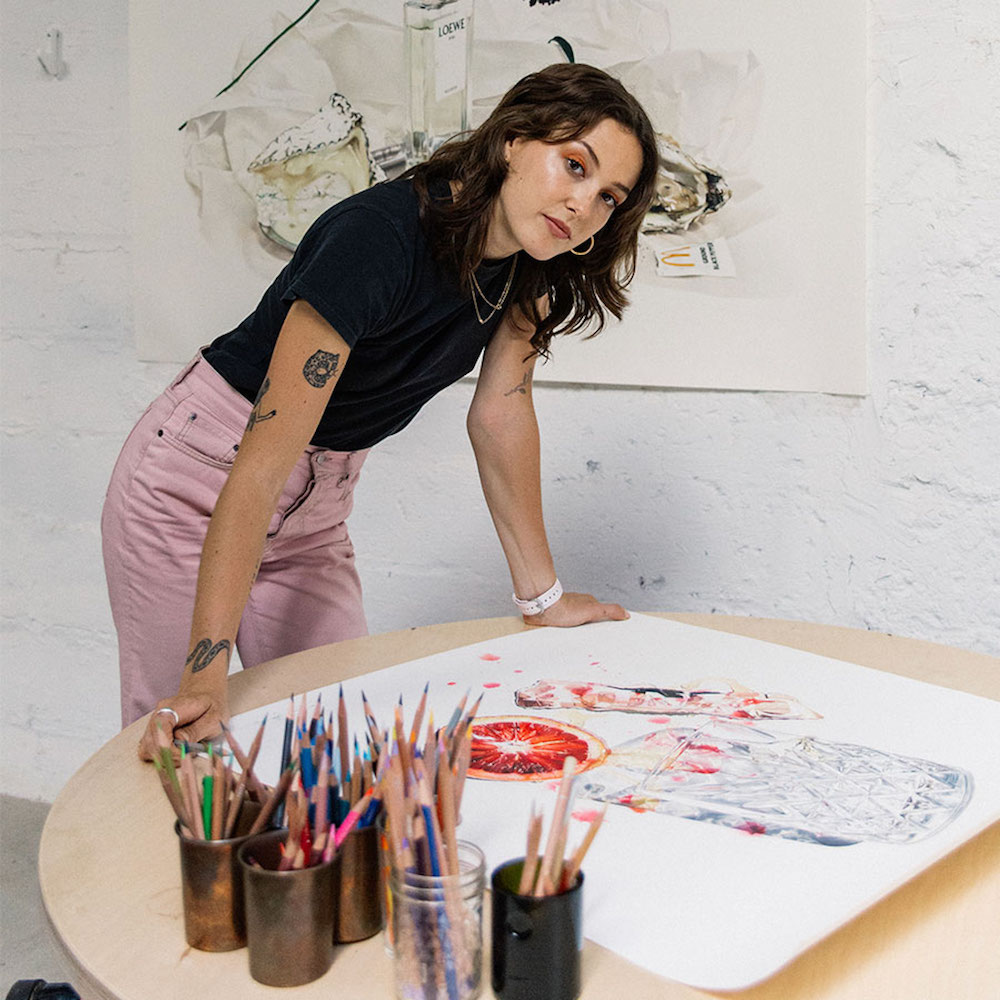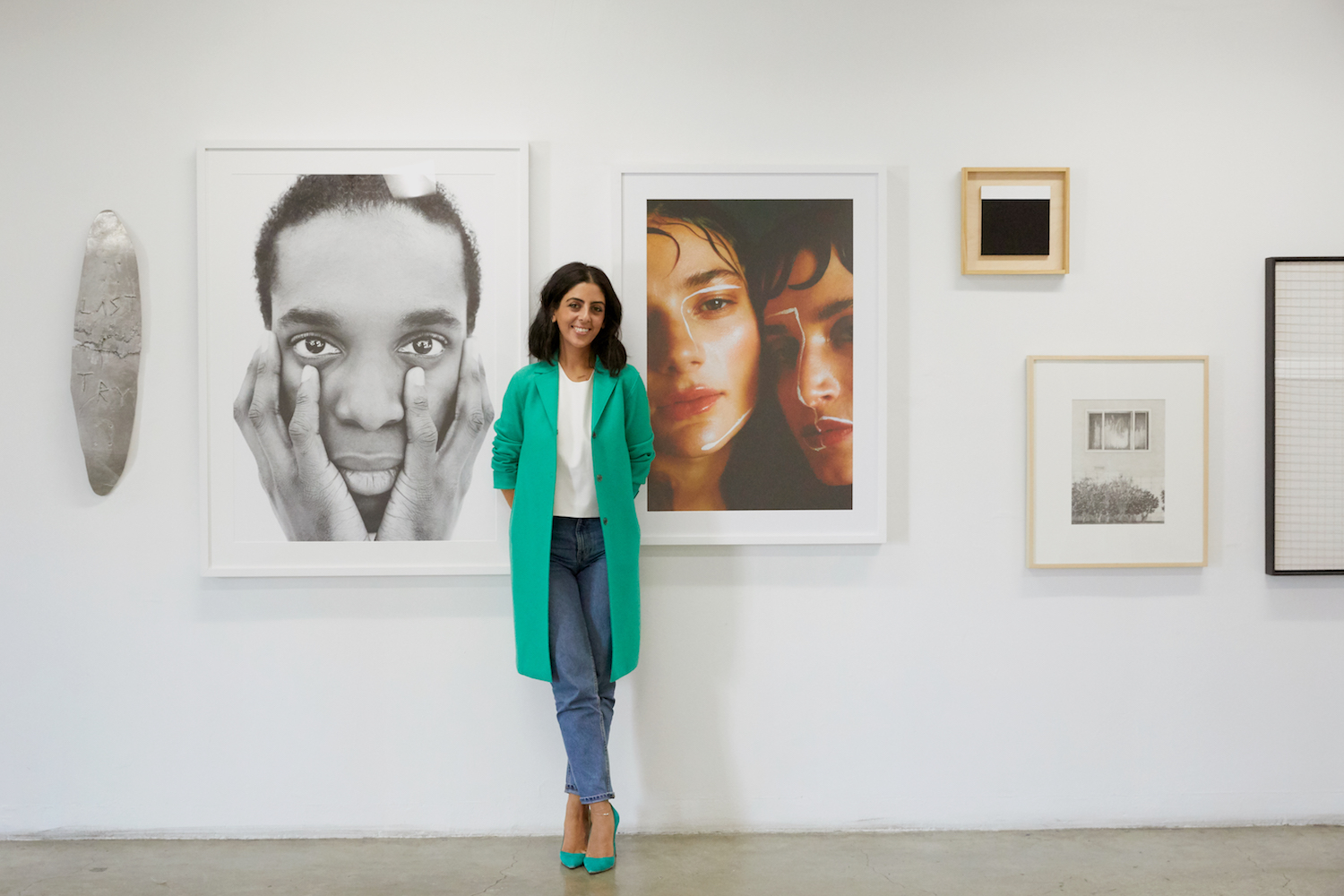Today through November 7, Tappan Collective is hosting its first-ever online auction to benefit Charity Water. The sale will feature one original work by the Australian artist Bella McGoldrick entitled Everything & Lox, a hyper-realistic color pencil drawing of the iconic New York bagel. Starting with a photograph, the piece took McGoldrick over 120 hours to create, highlighting ingredients—like the bagel’s various seeds, cream cheese, salmon, capers, and slices of onion—in immense detail.
“We could’ve gone with an egg and cheese addition, but I chose the expensive option—the option I used to have to miss out on when I first moved to NYC,” said McGoldrick. “It’s the staple food, but it’s the fancy one. It’s the subway and it’s the skyscrapers. It’s the greasy paper you trash and the framed artwork you hang. It’s me and it’s the partnership of high-low I live for.”
Ahead of the auction, Whitewall spoke with McGoldrick to hear how she created Everything & Lox, why Charity Water’s mission of human rights and sustainability is close to her heart, and what she’s up to next.
WHITEWALL: Let’s start from the beginning. How did you go from studying fashion design in Australia to thriving in the art world in New York?
BELLA MCGOLDRICK: I always loved art and drawing and I did it all throughout school. I couldn’t get enough of it. Coming out of highschool, I was tossing up art school or fashion school, and funny enough, I chose fashion. I thought there’d be more job opportunities coming out of it, which was literally the opposite and the reason why I ended up making art. I couldn’t get a design job in New York City!
I was doing fashion illustration portrait-type artworks throughout university, which became a hot trend among private school girls—18 to 21-year-olds—and then onto their mums. They make me totally cringe now, but I was doing almost seven a week and for around $250 a pop.
This allowed me to save for New York City and give me the realization that my art could make a living. Moving to New York City was something I decided when I was around 15, without ever visiting. There was no other option in my head. I romanticized it, and the U.S. in general. For instance, my eighteenth birthday was “Party in the USA”—again, without ever being there. So, as soon as I finished my honors program, I left with my best friend.
WW: You recently left New York City and moved to Colorado. What prompted that move? Do your new surroundings impact your work?
BM: I’ve been pretty displaced since the start of COVID. My boyfriend and I were packed up to move back to Australia for a bit, but that got put off, then my working visa was up. So, I was headed back to New Zealand—where I was born and half of my family lives—via London, and that got cancelled, too. So, I was living in London and Amsterdam for six months when my boyfriend fell in love with this little mountain town called Crested Butte. Having nowhere really to go, I went to try it out. And it’s incredible.
Over the pandemic, I grew a little tired of the hustle of the city. It just felt time for something new, and a massive part of this is my work. Neither it nor I could be inspired or affected more by my surroundings. As you can see in all my New York City-based work, it’s everything. And that city was everything to me.
I travel all the time and I have pieces related to most of those trips, too, so I thought it would be interesting to see what would happen to the work living more remote. What I find a cool challenge is the art that usually comes out of these places are landscapes and more traditional type paintings, so it leaves space for a new take on the land and surroundings, which I’m excited to explore.

Bella McGoldrick, Everything & Lox, courtesy of Tappan Collective.
WW: What was creating amid the pandemic like?
BM: In a way it was great. Working didn’t change for me, as I was working from the studio in my home anyway. So while everyone started working fro home, I just had more people to talk about it with! I was so grateful for my work and to be able to be busy in something, so I just put my head down and didn’t mind having less distractions.
The thing that sucked, and is still going on, is how displaced I’ve been the whole time—unable to get a visa appointment anywhere, unable to go back to Australia. I’ve been jumping around like a mad woman. I’ve traveled more in the pandemic than any other year of my life. It looks cool and exciting, and it can be, but really all I want is to be settled and focus on my work. So, my practice has gotten very good at being on the fly, which is a cool skill to have, but I am dying to be stable for a hot minute!

Bella McGoldrick, Everything & Lox, courtesy of Tappan Collective.
WW: Your works often depict everyday objects in a hyper-realistic nature. What types of items do you typically gravitate toward recreating?
BM: It changes, and has changed through time and practice. I was first attracted to textures; things that hold and reflect light, and that’s where all the crunching and destroying of the objects came from—trying to give them more highlights and shadows. But now it’s more about things that mean something to me; something from a certain place that meant a certain something to me; or of a time.
I love the way objects can relate to so many people in new ways. I often don’t like to detail too much why something was chosen, because for me it’s more interesting to see why viewers are attracted to it. I’m becoming more interested these days in a composition of different objects that in turn tell a story about the relationships between the objects. In the bagel piece, which you could say is just a bagel, it’s about the elements I chose to be in the piece, the type of bagel, the paper, the fillings, etc. They say something more interesting.

Bella McGoldrick, courtesy of Tappan Collective.
WW: What is your creative process typically like? Can you walk us through creating a work from scratch?
BM: Deciding what I want to draw is the hardest part. I usually have the next thing working out in my mind while I’m drawing a current piece. I have ideas I’ve stocked up on that haven’t found their way to best be executed, and I have weird miscellaneous objects around the studio that I’ve picked up from traveling or Etsy or whatever that have potential. I also have my boyfriend in my ear constantly saying, “Draw this! What about that?”
It takes time. And it takes looking through a lot of flea markets, antique shops, expensive delis… Honestly, it’s all things I do anyway, but now I can call it research. I travel a lot, which is essential. It could be cool vintage French graphic design, the way a Spanish green grocer displays their oranges, or an idea that I fall down a rabbit hole over on eBay and find something really old and great. But it’s usually one thing that catches me, and then I’ll work around that.
WW: Tomorrow, Tappan is hosting its first-ever auction with your work, Everything & Lox. Why did you choose this iconic NYC food item?
BM: New York City influenced everything about my art when I started. I love that city and it’s so insane and inspiring. I’ve played around with it’s iconography in other works—from a New York City pizza slice to a bodega coffee cup and lottery tickets I would see in the street. There’s so much you could do, but this just called to me.
When I was living in Melbourne growing up, there was this really cool, tiny little bagel place down a narrow laneway in the city. My mum would take us to it if we ever met her at work in the city, which was a real “big girl in the city” moment. It was a New York Bagel spot called Jungle Juice. I don’t even know if it was run by Americans, but I thought it was hands down the coolest place in the world. The bagels were dank, too! It was this feeling of eating something “foreign” and wanting so badly to be there. It’s still my favorite place in Melbourne, but the bagel said something more to me.
Then, when I moved to New York City, I was broke and could only eat the bodega egg and cheese bagel. The lox was way out of my league. So, I’ve played on this thought of New York City before I had ever touched foot there, endlessly cool and aspirational, and the New York City when I left, which felt small—in a fantastic way—and affordable and home. It’s the city that is the “everymans,” like the bagel, but it’s also the place where there’s always going to be someone richer, something fancier, something able to top you. A salmon and capers open bagel at the Plaza, shall we say.
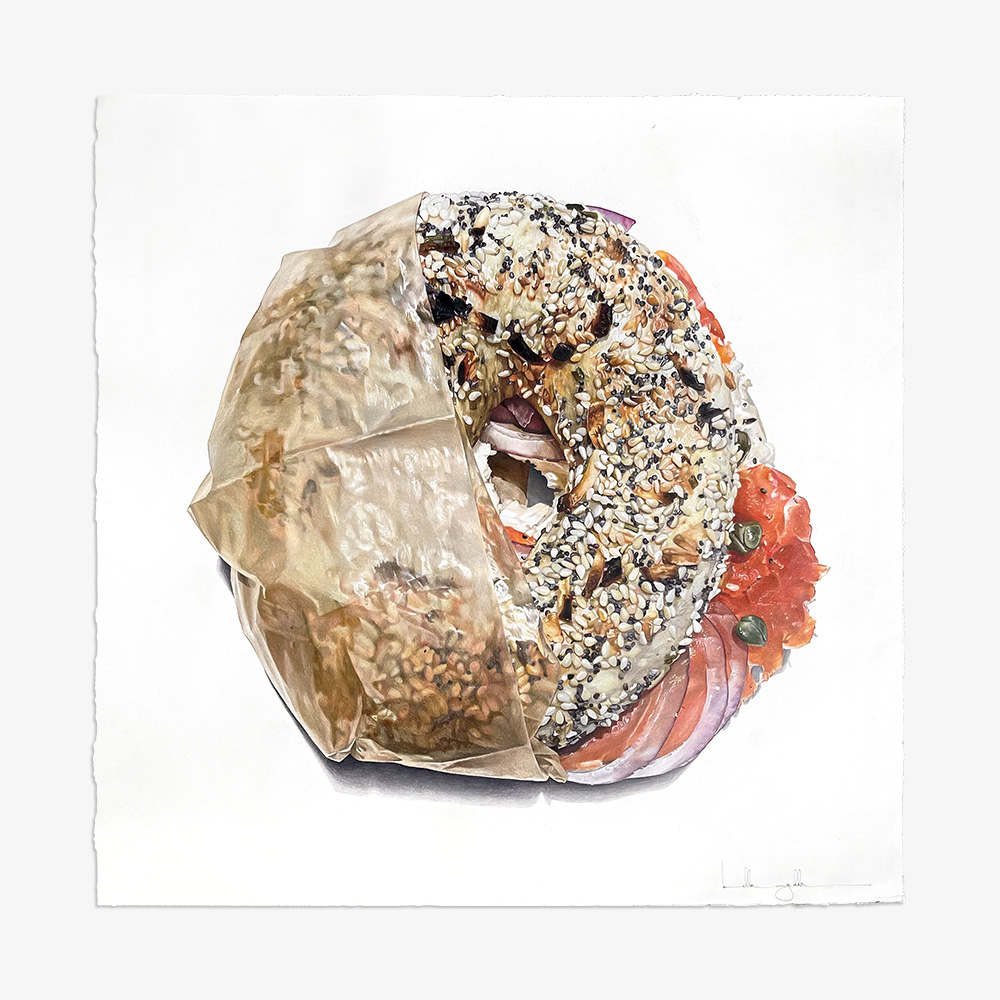
Bella McGoldrick, Everything & Lox, courtesy of Tappan Collective.
WW: The work represents a bit of high-low lifestyle. Can you tell us a bit about this, and how your high-low lifestyle plays out today?
BM: A theme I love and comes through in all my work, and my way of life, is this idea of high-low—or as I like to call it “tacky versus fantastic.” It’s this idea of things overlooked, or even looked down upon. Things tossed in the trash or used as a vessel for something else. I like those things. I think they’re beautiful. I like the grease left on a piece of paper once the meal has been devoured. I like coffee stains on teeth and creases on a dress that should’ve been smoothed.
Putting so much time into creating these works, and putting them on a clean white page and a nice expensive frame on a large empty wall, says something different to seeing something that’s missed the bin and sits on the curb. Or something that demands to be eaten with dirty fingernails on a stoop to cure a hangover. Messy shit is cool. And making it look expensive is perhaps tacky or shameless. But, you see, that’s all I’m ever after—for someone to ask, “Is that really tacky or fantastic?”

Bella McGoldrick, Everything & Lox, courtesy of Tappan Collective.
WW: Everything & Lox took over 120 hours to create. What was that process like? Was there anything that was uncompromisable to include?
BM: Once I decide what it is I want to draw, I need to have the object in hand with other things around that I might want to be included. I then photograph the composition, usually in direct sunlight at noon. This is the best lighting for me. I’ll photograph it then work on it, add subjects, remove subjects, play around with what I really want. Once I have the shot—this is the most important part, as this is what the drawing will look like, almost exactly, so this can take a few attempts to make perfect—I’ll grid up my page, and start laying it out in graphite loosely to get the proportions in.
From then on, it’s all very formulaic. I draw every day, around five to seven hours. I start in one corner and I work my way around until it’s complete. I’m getting slower as I do this for longer, because I’m getting better, and getting better is simply by being more patient and including more detail.
In terms of specific details I have to include, that is every single speck I see. The more I put in, the better it looks. There’s comfort in that, unlike other art mediums or practices. I know exactly how it’s going to turn out. There’s no risk, only if I have the patience to keep at it, which I manage to always keep. If I’m pleased with the photo, I will be pleased with the result. I’m only ever doing one artwork at a time, and they take roughly a month per piece.
WW: The auction benefits Charity Water, a non-profit that’s important to you. Why is this something that’s close to your heart?
BM: I’ve been supporting their work for a few years now. I’ve been to their seminars and seen the incredible work they do. I feel like they really show you where your support is going and how it’s making changes. More importantly, their mission takes it all back to the most basic level—human rights and needs.
I’m one that is so passionate about waste and single-use plastic and you can see these themes in my work, but there is a sort of privilege in being in this position, I’m here worrying about using single-use water bottles when there is a huge population that is worried about or even unable to get any clean water at all. It’s the great equalizer, or it absolutely should be. Never mind the high-minded notion of high and low—this is about human rights and all people having access to life, and water is number one. Let’s start there, and then we can worry about reusable drink bottles.
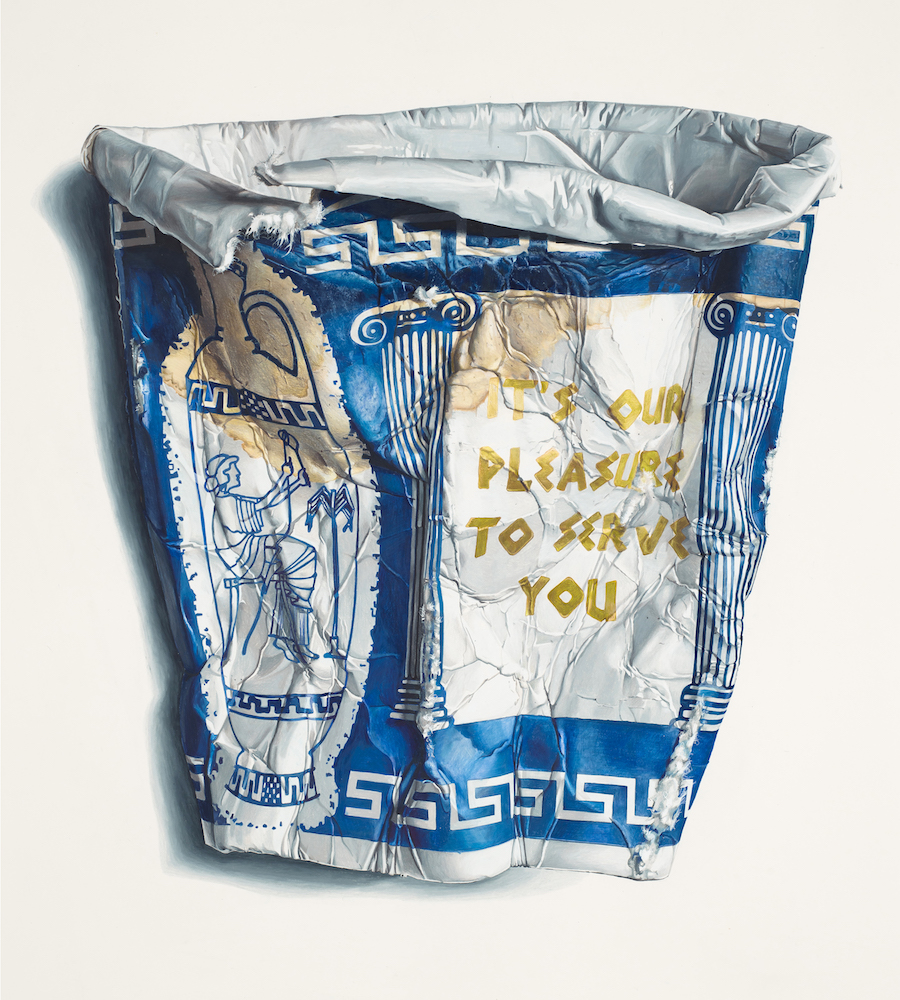
Bella McGoldrick, courtesy of Tappan Collective.
WW: Your work often details how objects transform with use and time. Where did this thought begin?
BM: Ugh, it’s the best—old wear and tear. It’s the messy thing I was talking about. New things are cute, but where’s the human interaction with them? I chose things that mean something to me. If not, they definitely meant something to someone at one stage. I don’t remember if it was the lottery tickets or the Vegas slots cup that came first, but these are where the obsession started.
The Vegas cup I found in a pawn shop on the outskirts of Vegas—a place that blew my mind. It was old, browned, and the lady told me it was used to collect winnings at slot machines. My mind flew to all the people that were hopeful, maybe drunk, maybe winning but probably losing, sitting, and holding that hopeful cup to fill their dreams. The U.S. has so much of this stuff, and I’m obsessed with it. The objects are so cool in themselves; I’m just honored to be able to represent them and pay tribute to their history in a more permanent and viewable way.
In Single Serving, a drawing of an orange wrapped in plastic, I was trying to immortalize a mortal fleeting thing. Plastic obviously wouldn’t cut it, so I drew it and played on the notion of living things and our plastic obsessed culture that’s “made to last,” but gets discarded quicker than the dying fruit.
I’m always trying to connect with the user of these items. Who were they, and what were they using these items as a vessel for? Then, with the viewer of the artwork, have they seen these things but never really paid attention? Ultimately, I’ve done a good job when I’m able to connect with something within myself. And that, if it happens, usually comes long after the artwork is complete.
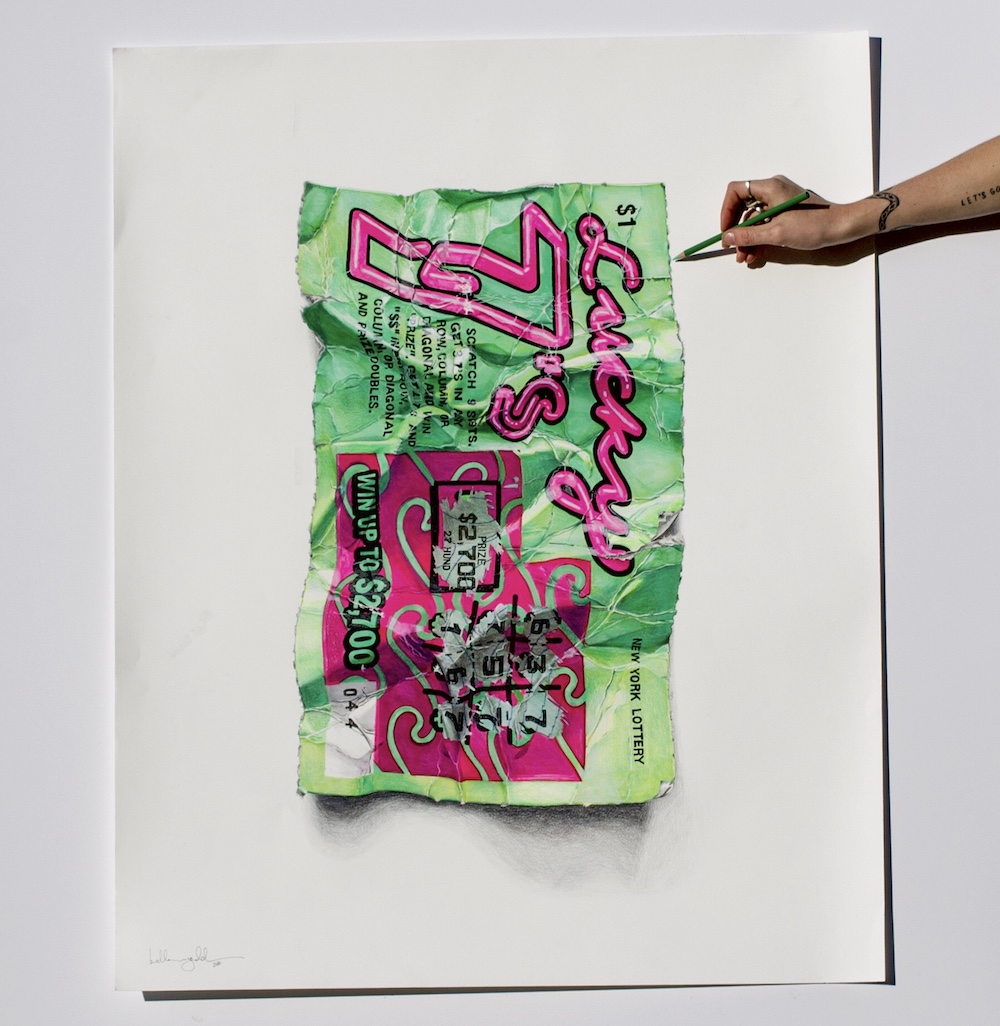
Bella McGoldrick, courtesy of Tappan Collective.
WW: Most of your subjects have a symbolic meaning attached to them. Is there a piece that is more symbolic to you personally than others?
BM: There actually is one that’s totally personal, and I didn’t even think it as I was creating. It was my mum that asked about it later, and she was right. It’s Lifestyles Come Undone, a drawing of a Lifestyles condom and a piece of yarn that’s being unraveled.
I picked up the condom from a very unpleasant and difficult visit to Planned Parenthood. I thought I was just attracted to its texture and reflective surface. When I later photographed it, and paired it with the yellow string, I thought it was its opposite texture that made it interesting. In hindsight, this was a really awful time in my life. My plans had unraveled like the string had and I guess I was trying to immortalize or signify something in my life. Not having the words to do so or even being conscious in my mind, this artwork came out of it. Something that I couldn’t really talk about became art that could mean whatever the viewer wanted from it, and that felt freeing in a way.
WW: What are you working on next?
BM: I’m really excited to have just signed a new contract with Tappan and to continue our work together. They’ve been great and I love working not totally solo anymore. I have two more original artworks due to be released before the end of the year, and while I’m hoping to be settled in one spot for a bit, I’ve been traveling for the last two months and gathered a few things I’m excited about. It would be cool to do a whole collection, but again, I think due to the time it takes to complete one piece, I enjoy bringing them out one by one. I can’t seem to stay excited by one idea for long enough.
Something Coloradan-themed is definitely due to arrive soon, and probably an ode to my home country Australia. I’m always inspired by food, and that’s a limitless field, but I’m definitely tapping a little more into my messages and what I want to say with my pieces, hoping that my portfolio says something about me in its entirety.



